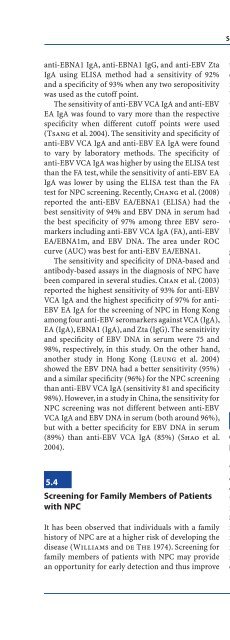Familial Nasopharyngeal Carcinoma 6
Familial Nasopharyngeal Carcinoma 6
Familial Nasopharyngeal Carcinoma 6
- No tags were found...
Create successful ePaper yourself
Turn your PDF publications into a flip-book with our unique Google optimized e-Paper software.
Screening and Early Diagnosis of <strong>Nasopharyngeal</strong> <strong>Carcinoma</strong> 57anti-EBNA1 IgA, anti-EBNA1 IgG, and anti-EBV ZtaIgA using ELISA method had a sensitivity of 92%and a specificity of 93% when any two seropositivitywas used as the cutoff point.The sensitivity of anti-EBV VCA IgA and anti-EBVEA IgA was found to vary more than the respectivespecificity when different cutoff points were used(Tsang et al. 2004). The sensitivity and specificity ofanti-EBV VCA IgA and anti-EBV EA IgA were foundto vary by laboratory methods. The specificity ofanti-EBV VCA IgA was higher by using the ELISA testthan the FA test, while the sensitivity of anti-EBV EAIgA was lower by using the ELISA test than the FAtest for NPC screening. Recently, Chang et al. (2008)reported the anti-EBV EA/EBNA1 (ELISA) had thebest sensitivity of 94% and EBV DNA in serum hadthe best specificity of 97% among three EBV seromarkersincluding anti-EBV VCA IgA (FA), anti-EBVEA/EBNA1m, and EBV DNA. The area under ROCcurve (AUC) was best for anti-EBV EA/EBNA1.The sensitivity and specificity of DNA-based andantibody-based assays in the diagnosis of NPC havebeen compared in several studies. Chan et al. (2003)reported the highest sensitivity of 93% for anti-EBVVCA IgA and the highest specificity of 97% for anti-EBV EA IgA for the screening of NPC in Hong Kongamong four anti-EBV seromarkers against VCA (IgA),EA (IgA), EBNA1 (IgA), and Zta (IgG). The sensitivityand specificity of EBV DNA in serum were 75 and98%, respectively, in this study. On the other hand,another study in Hong Kong (Leung et al. 2004)showed the EBV DNA had a better sensitivity (95%)and a similar specificity (96%) for the NPC screeningthan anti-EBV VCA IgA (sensitivity 81 and specificity98%). However, in a study in China, the sensitivity forNPC screening was not different between anti-EBVVCA IgA and EBV DNA in serum (both around 96%),but with a better specificity for EBV DNA in serum(89%) than anti-EBV VCA IgA (85%) (Shao et al.2004).5.4Screening for Family Members of Patientswith NPCIt has been observed that individuals with a familyhistory of NPC are at a higher risk of developing thedisease (Williams and de The 1974). Screening forfamily members of patients with NPC may providean opportunity for early detection and thus improvethe outcome of the subjects who are at high risk ofdeveloping NPC. Ng et al. (2005) screened 929 familymembers of NPC with EBV seromarkers (anti-EBVVCA IgA and anti-EBNA-1 IgA), physical examination(to exclude cervical lymphadenopathy and cranialnerve palsy), and endoscopic examination of thenasopharyngeal region. Twelve cases of NPC wereidentified, of whom 5 (41%) had Stage I disease (notethat only 2% of patients referred for primary treatmentpresented with such early disease), during amedian follow-up of 29 months. Based on the initialserology results, the sensitivity and specificity of EBVserology was 75% and 92%, respectively. There is asupplementary role for the use of routine endoscopy:one additional case of NPC with negative EBV serologywas diagnosed among the 12 diseased patients.On the other hand, the DNA-based assays have notbeen tested in this setting.Taken together, results from earlier studies suggestthat both EBV DNA and anti-EBV antibodies aresensitive markers in the screening and diagnosis ofNPC. However, the validity for prediction of NPCusing multiple seromarkers has not been extensivelyinvestigated partly due to the lack of longitudinalfollow-up data, and also because only one or twoseromarkers have been examined in most of the earlierstudies. Further evaluation of this topic is warrantedin larger studies or those with longer follow-upto better define the specific performance characteristicsof using repeated screening for specific EBVmarkers for NPC prediction. Feasibility and costeffectivenessof using these seromarkers in EBVscreening programs aimed at the prevention of NPCin endemic areas also require evaluation.5.5Clinical Methods for Screening and EarlyDiagnosis of NPCThe majority of NPCs arise in the lateral walls, especiallyfrom the fossa of Rosenmüller and Eustachiancushions. Few initial symptoms are directly referableto NPC. Neck mass, blood tinged sputum and/orrhinorrhea are common clinical presentations.Sometimes the tumor can present a variety of local,regional, and distant signs and symptoms, such asnasal symptoms (nasal obstruction, and increasingnasal discharge), aural symptoms (tinnitus, stuffiness,and hearing loss), headache, facial pain or paresthesia,diplopia, and weight loss. The nasopharynx











